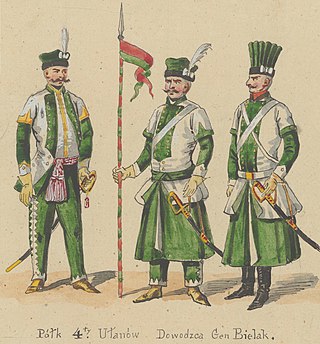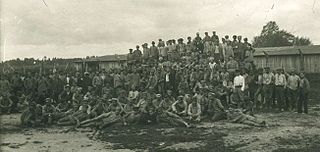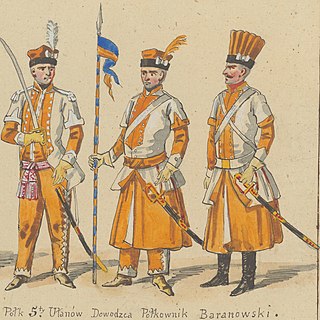
Prince Eustachy Erazm Sanguszko (1768–1844) was a Polish nobleman, general, military commander, diplomat and politician.

The Lithuanian Wars of Independence, also known as the Freedom Struggles, refer to three wars Lithuania fought defending its independence at the end of World War I: with Bolshevik forces, Bermontians, and Poland. The wars delayed international recognition of independent Lithuania and the formation of civil institutions.

Jan Chrzciciel Henryk Witold Wołodkowicz was a Lithuanian nobleman from the Wołodkowicz family of the Radwan coat of arms. Initially, he served as cavalry captain in the Grand Ducal Lithuanian Army from 1789 to 1794. Joining the French Revolutionary Army in 1796, he rose to the rank of general, which he kept in the Grande Armée. He was also one of Napoleon's Aide-de-camp.

Jakub Krzysztof Jasiński of Rawicz Clan was a Polish general, and poet of Enlightenment. He participated in the War in Defence of the Constitution in 1792, was an enemy of the Targowica Confederation and organized an action against its supporters in Vilnius. He participated also in the Kościuszko Uprising, during the course of which he was killed in the Battle of Praga in 1794.

The 4th Lithuanian Vanguard Regiment was a military unit of the Grand Duchy of Lithuania. The full name was 4th Lithuanian Advance Guard Regiment of Josef Bielak.

The National cavalry was a branch of Polish–Lithuanian cavalry in the Polish-Lithuanian armed forces in the last quarter of the 18th century. Formed as a merger of previously-existing units of Winged hussars, pancerni and petyhorcy that were still in service after the Confederation of Bar. In 1777 the Sejm new regulations converted all units of heavy cavalry and medium cavalry and reformed them into a line cavalry, roughly similar to later uhlans popular in Europe in the 19th century. Existing dragoon and Front or Vanguard Regiments were outside this reform The National Cavalry had a very short history of 20 years, and some units stationed in the eastern Polish–Lithuanian Commonwealth were forcibly incorporated into the Russian cavalry following the Second Partition of Poland, and the remainder was disbanded together with the rest of Polish–Lithuanian armed forces after the final partition in 1795. The Sejm's 1777 decision was a rather late effort to modernize Polish–Lithuanian cavalry, along with the much earlier trend of evolution of European cavalry towards the more modern organization of the cavalry regiments into more mobile formations. The most modern part of the reform was the establishment of some very modern battle dress uniforms for these cavalrymen, and in turn, this uniform of the National Cavalry inspired numerous similar uniforms and employment of 'Polish lance' in the rest of Europe, notably the Austrian, Prussian, Russian cavalry, and later of the French cavalry of the Napoleonic Wars.

The Lithuanian–Soviet War or Lithuanian–Bolshevik War was fought between newly independent Lithuania and the Russian Socialist Federative Soviet Republic in the aftermath of World War I. It was part of the larger Soviet westward offensive of 1918–1919. The offensive followed the retreat of German troops and sought to establish Soviet republics in Ukraine, Belarus, Lithuania, Latvia, Estonia, Poland and link up with the German Revolution. By the end of December 1918 Soviet forces reached Lithuanian borders. Largely unopposed, they occupied one town after another and by the end of January 1919 controlled about two thirds of the Lithuanian territory. In February, the Soviet advance was stopped by Lithuanian and German volunteers, who prevented the Soviets from capturing Kaunas, the temporary capital of Lithuania. From April 1919, the Lithuanian war went parallel with the Polish–Soviet War. Poland had territorial claims over Lithuania, especially the Vilnius Region; these tensions spilt over into the Polish–Lithuanian War.

The Lithuanian Land Forces (LLF) form the backbone of the Lithuanian Armed Forces, capable of acting as an integral part of NATO forces. Lithuanian Land Forces consist of three brigades, the Engineer Battalion, and the National Defence Volunteers Division.
The Army of the Moselle was a French Revolutionary Army from 1791 through 1795. It was first known as the Army of the Centre and it fought at Valmy. In October 1792 it was renamed and subsequently fought at Trier, First Arlon, Biesingen, Kaiserslautern, Froeschwiller and Second Wissembourg. In the spring of 1794 the left wing was detached and fought at Second Arlon, Lambusart and Fleurus before being absorbed by the Army of Sambre-et-Meuse. In late 1794, the army captured Trier and initiated the Siege of Luxembourg. During the siege, the army was discontinued and its divisions were assigned to other armies.

Charles Eugène of Lorraine was the head of and last male member of the House of Guise, the cadet branch of the House of Lorraine which dominated France during the Wars of Religion, remained prominent as princes étrangers at court throughout the ancien régime, and participated in the émigré efforts to restore the Bourbons to the throne. He was an officer in the French and Habsburg militaries during the French Revolutionary and Napoleonic wars.
Antoine-Louis Decrest de Saint-Germain, Count de Saint-Germain and of the Empire was a French soldier of the French Revolutionary Wars, who later rose to the top military rank of General of Division, taking part to the Napoleonic Wars as a commander of cavalry.

General Sir David Dundas was a British Army officer who fought in the Seven Years' War and French Revolutionary Wars, wrote important texts on the Principles of Military Movements and then served as Commander-in-Chief of the Forces from 1809 to 1811.
Michał Wielhorski (1755–1805) was a Polish-Lithuanian count. In 1789, he was a brigadier of the Polish Crown Army. In 1792, he was made a lieutenant general of that army and he fought in the War of 1792. During the Kościuszko Uprising, he was a lieutenant general of the Grand Ducal Lithuanian army.

Karol Anders was a Colonel in the cavalry of the Polish Army, brother of Lt. General Władysław Anders and Colonel Tadeusz Anders, and double recipient of Poland's Virtuti Militari – IV and V Class.
Antoni Chlewiński (1750-1800) was a prominent member of the Polish-Lithuanian landed gentry of the Radwan coat of arms. A lieutenant general of the Lithuanian Army, he fought in both the War of 1792 and Kościuszko Uprising of 1794.

The 5th Lithuanian Vanguard Regiment was a military unit of the Grand Duchy of Lithuania. The full name was 5th Lithuanian Advance Guard Regiment of Stanisław Byszewski.
The 1st Lithuanian Vanguard Regiment was a military unit of the Grand Duchy of Lithuania. The full name was 1st Advance Guard Regiment of HM the Grand Duke of Lithuania.

Romuald Giedroyć was a Polish-Lithuanian prince from the Lithuanian princely Giedraičiai family, who fought in the Bar Confederation, War of 1792 and the Uprising of 1794 as part of the Grand Ducal Lithuanian Army. From mid-1812 to early 1813, Giedroyć was also the commander of the Lithuanian regiments raised during the French invasion of Russia. In early 1813, he was captured by the Russians and exiled to Arkhangelsk. In 1815, Alexander I of Russia amnestied Giedroyć and made him a Lieutenant general of the Army of Congress Poland.
The 5th Infantry Regiment, later the 5th Infantry Regiment of the Lithuanian Grand Duke Kęstutis was an infantry regiment that served in the Lithuanian Army during the Interwar period.

Stasys Nastopka was a Lithuanian military officer during World War I and the Lithuanian Wars of Independence.















